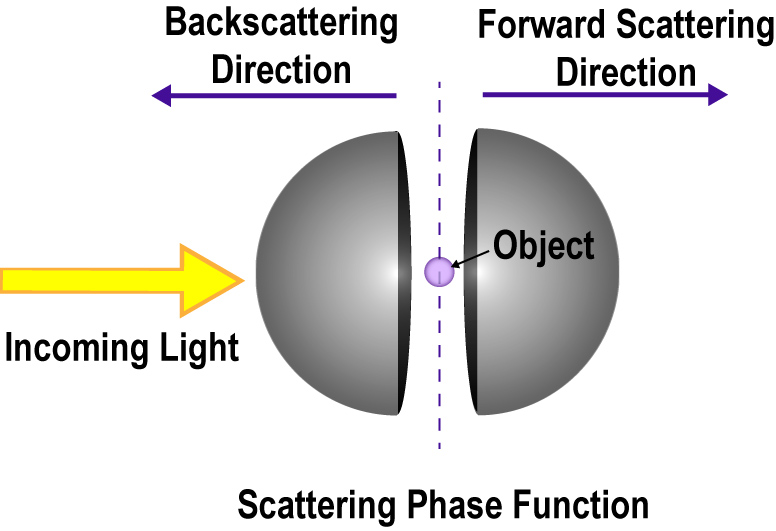When light interacts with a medium or object, there are three options: (1) it can be absorbed, that is the light “disappears” and is converted into another form, such as heat or used in a chemical reaction (think photosynthesis); (2) it can be scattered, which changes its direction and/or wavelength; or (3) it can be transmitted through, that is pass straight through with no change in its angle or energy.
Since energy is conserved we can summarize these options in the following equation:


When we look at an object or medium with light shining on it, what we are seeing is the light that has been reflected, or scattered, off of it. So our yellow banana is yellow because wavelengths of yellow light have bounced off of it and the other wavelengths have been absorbed. We see these as colors, but scientific instruments, like on the PACE satellite see these photons as a spectral signature of reflectance per wavelength. In this way, spectral signatures can be used to define a unique pattern of wavelengths radiated by a medium or object, like a fingerprint. For more of a background look at spectral signatures of light, check out What Determines the Color We See?
Knowing the “spectral patterns” of a medium or object is a key component to the creation of forward models.
Once we know the spectral signatures of individual elements of the ocean and
atmosphere we can use those spectral signatures as clues to discern the types of media or objects that light encountered during its journey to the PACE satellite.


The idea of a spectral signature being used as a fingerprint can even allow scientists to identify the type of phytoplankton in the water. While they all share roughly the same spectral shape, with high enough resolution data, you can pick out the subtle differences between say a diatom and a dinoflagellate.


Let’s dig more into what is happening to incoming sunlight as it interacts with components of the atmosphere and ocean to create these spectral signatures.

Asorption Coefficient is the fraction of light that is absorbed by a medium or object across a specific distance as a function of wavelength. Chlorophyll-a, for example, is a pigment found in many phytoplankton that strongly absorbs purple and red. Q: If purple and red are absorbed, which visible colors will be seen by eye (or the PACE satellite)? A: Greens and blues
.
Total Scattering Coefficient is defined as the fraction of light that is scattered by a medium or object across a specific distance as a function of wavelength. Typically, we only focus on the fraction of scattering that is deflected back to our eyes or up toward the satellite… known as the “backscattering coefficient.”

Beam Attenuation Coefficient is a measure of light that was not directly transmitted through a medium. Simply put, it is the sum of the absorption and scattering coefficients.

Single Scattering Albedo is the probability that light is scattered versus absorbed by a medium. It is calculated as the ratio between the total scattering coefficient and beam attenuation coefficient (which as noted above is the sum of the absorption and total scattering coefficients). When the ratio is closer to 1, the medium primarily scatters light. When the ratio is closer to 0, the medium primarily absorbs light. This can tell you a lot about the ocean environment as, for example, if the single scattering albedo is closer to one, perhaps the water has a lot of minerals and suspended sediment which scatter light, or if it is closer to zero, perhaps it has more colored dissolved organic material (CDOM) which absorbs light.
So far, we have been talking about scattering in terms of “how much” scattering there is, or its total magnitude. But we also need to address where scattered light goes, in particular, along which angles it travels away from the source. It’s analogous to velocity having both a speed and a direction.
Typically, we only focus on the fraction of scattering that is deflected back to our eyes, or up toward the satellite … known as the Backscattering Coefficient. Without backscattering, there would be no remote sensing as there would be no light traveling back to the satellite to be measured!
Of course, when an object scatters light, it is typically more complex than “forward” and “backward.” In fact, it is scattered across numerous angles! The specific term for the angular distribution of scattered light is known as the Scattering Phase Function. Scattering Phase Function is an array of numbers that tells you how much scattering is happening at every angle within a hemisphere. The hemispheres are divided in terms of angles in the forward and backward direction.
You may be wondering: "What does 'phase' have to do with angles?" The term "phase angle" comes from astronomy and refers to the angle between an observer, an object, and a light source. So, for example, the phase angle of the moon is calculated by calculating the angles between the sun, the moon, and the earth's surface and corresponds to the "phases" or the moon – i.e., waxing, waning, etc. Check out these cool NASA images made possible by taking advantage of properties of light from different "phase angles." – Just a Phase; High-phase Rings.
Learn more about scattering in the StoryMap Something New Under the Sun .
For more details and equations check out the IOP , Absorption , and Scattering sections of the Ocean Optics Web Book.








